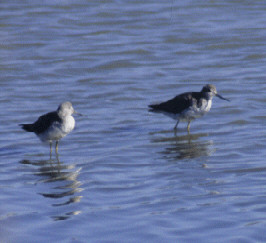WATER AND SHORE BIRDS
These are birds found in or very near water in aquatic or wetland habitats
such as marshes, ponds, lakes, bays, and streams. This group includes
grebes, loons, cormorants, ducks, geese, herons, sandpipers, rails, gulls,
and others.
Aix sponsa
L: 18.5"
The male duck has distinctive plumage and a crest of brilliant colors. The head and crest are green with white streaks, and the throat is white. The breast and neck are brown while the flank is a buffy color with black and white bands in front. The eye and upper bill are red. The female is light brown with white teardrop shaped eye patches. Locally found in ponds and creeks as well as adjacent woodlands.
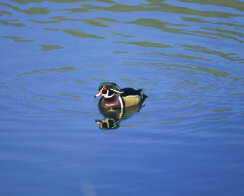
Anas acuta
Anas americana
L: 19"
A common medium size duck. The male has a white cap and forehead with a green stripe running from the eye to the back of the neck. These markings are absent from the female. Both sexes have a buff colored breast and sides white auxiliaries and a green colored speculum.
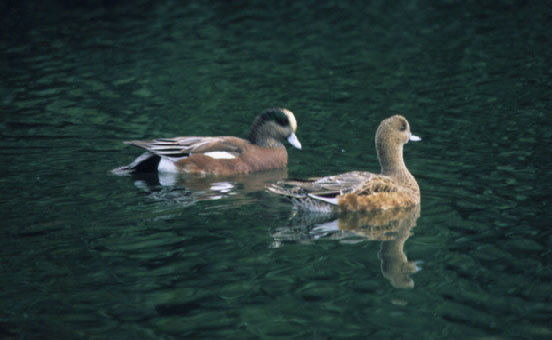
Anas clypeata
L: 19"
A common marsh duck distinguished by its large spatula shaped bill. The male has a green head, yellow eye, white breast, and brown sides. The female has mainly brown coloring with green speculum on it's wings.
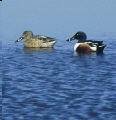
Anas platyrhynchos
L: 23"
This species is the most common dabbling duck found in this area. The male has a glossy green head, chestnut breast and a yellow bill. The female is varying shades of brown (and can be confused with other species) with blue speculum and orange bill. Juveniles are similar to the female but have a pale olive colored bill.
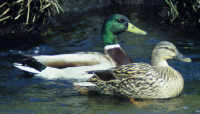
Anas strepera
Aythya collaris
Aythya marila
Branta canadensis
L: 25-45"
This is the most common goose species in the area. A distinctive black head and neck with a white chin strap are markers for the species. Usually seen in flocks or pairs in or near larger bodies of water, also seen in open fields and vegetated clearings along creeks. This is where they feed on terrestrial plants.
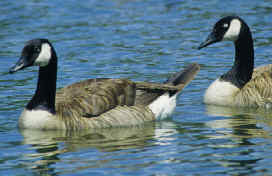
Bucephala albeola
L: 13.5"
A fairly common small duck with a short bill, and large head. The male has a black underside with a large white patch towards the back of the head. The female is more subdued with a smaller white head patch.
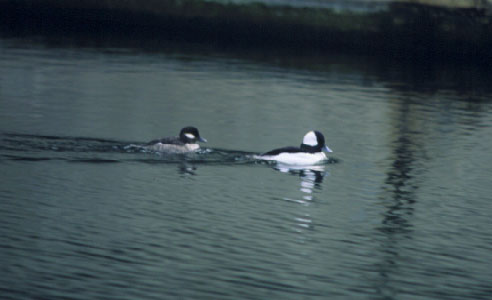
Bucephala clangula
Oxyura jamaicensis
Ardea herodias
L: 46" W: 72"
A large grey-blue wading bird with a black stripe above the eye extending into a tuft of feathers at back of the head. The long, pointed, yellow bill is used to spear fish and other prey. Commonly found in marsh, pond, and creek habitats.
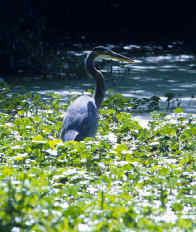
Butorides striatus
L: 18" W: 26"
A small heron with blue-green top half and brown neck and cheeks. This bird has a long pointed bill; the feet and legs are yellow. Immature birds are brown on top and streaked on their underside. A solitary bird, found along streams, in ponds, and in marshes with vegetated cover.
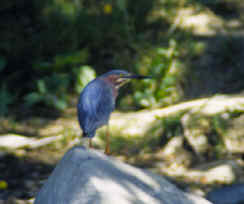
Casmerodus albus
L:39" W: 51"
A large white wading bird with a yellow, pointed bill. This species has black legs and feet. Commonly found in marshes, ponds and creeks. Occasionally, it is found in open fields searching for insects, reptiles, and small mammals.
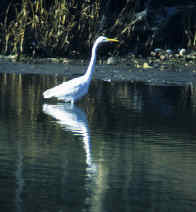
Egretta thula
L: 24" W: 41"
A white wading bird that is similar to Great Egret only smaller. The bill is black with yellow lores in front of the eyes. This egret has black legs with yellow feet. It usually feeds more actively than the Great Egret by wading along and stirring up the bottom with it's feet and capturing it's prey with it's bill.
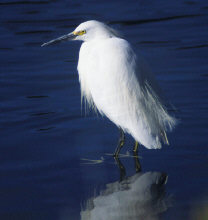
Nycticorax nycticorax
L: 25" W: 44"
A stocky heron with a short neck. Adults have a black crown and a black and white neck. They have red eyes and both legs and feet are yellow. Juveniles are brown above and streaked on the breast.
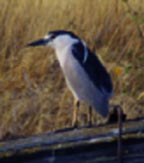
Charadrius vociferus
L: 10.5"
A species of plover common to shorelines, riverbanks, and fields. This bird is identified by its distinctive double breast bands. The diagnostic call of the bird is a sound similar to "Kill-dee" and "dee-dee-dee" both calls are rather loud.
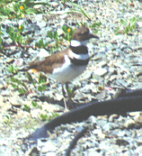
Gavia immer
Larus argentatus
L: 25" W: 58"
This is one of the most common gull species in this area. Both the adult and juvenile plumage is similar to other species, but it is larger in size. It can be distinguished from the Ring-billed and California gulls by its pink legs and feet. The adult has a red spot on the lower tip of its bill while the California gull has both red and black marks. This gull will feed on a wide variety of live prey, but will also scavenge for dead animals and garbage.
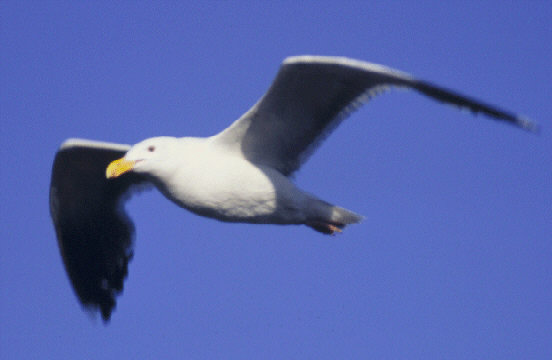
Larus californicus
Larus delawarensis
L: 17.5" W: 48"
A common gull similar in coloring to the Herring and California gulls but smaller in size. It has a black ring near the tip of it's bill and yellow legs and feet. The juvenile birds are mottled with brown over the head, neck, back, and sides.
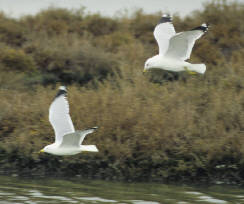
Larus occidentalis
Stera forsteri
L: 14..5"
A gull-like bird with pointed wings and bill, a pale grey back and white breast with a black cap on head and nape are the main colorings of this bird. This bird has an orange bill with a black tip, and its legs and feet are orange. It is the most common tern found in marshes and creeks in the area. They are often found diving to capture prey. The lesser seen Least Tern is smaller, with a yellow bill, legs and feet. The Caspian Tern is larger with a shorter tail, longer bill, and black legs and feet.
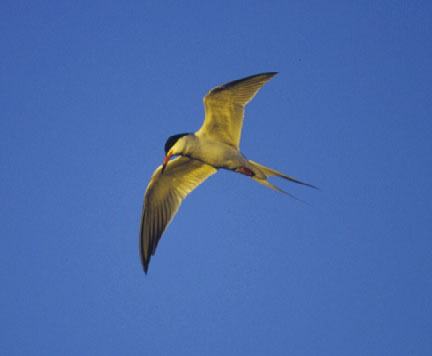
Stera caspia
Phalacrocorax auritus
L: 32" W: 52"
A large black diving bird with a yellow to orange throat pouch. The tufts of feathers above the eyes (double crests) are not always visible. The feet are black and webbed. Commonly found in ponds, lakes, larger creeks, and rivers. Often observed diving from the water's surface for fish.
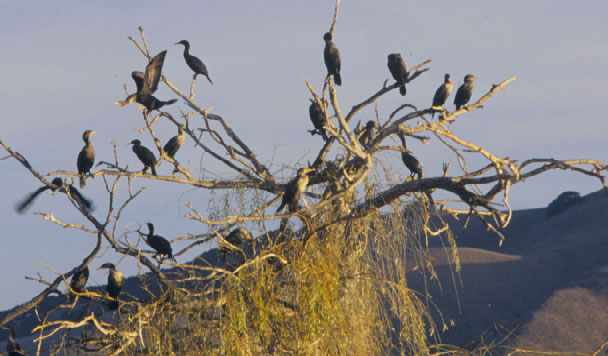
Podilymbus Podiceps
L: 13.5"
A small swimming and diving bird, with a dark brown top half and a lighter brown underside. This grebe has a diagnostic black ring around a whitish bill. It is found in ponds, sloughs and larger creek areas where it catches fish as its main source of nutrition.
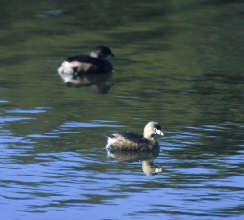
Fulica americana
L: 15.5"
A black duck-like swimming bird with a white bill and red eyes. Its yellow feet are lobed rather than webbed. A very common species in marshes, wetlands, ponds and lakes.
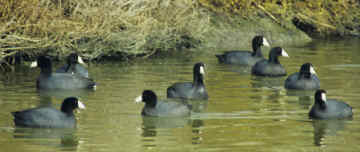
Rallus logirostris
L: 16"
This endangered species has a short tail, strong legs, and short rounded wings. It has heavy white bars on its gray-brown sides. It feeds on rock louse, crabs, or snails.
Himantopus mexicanus
L: 14"
This is a very distinctive black and white shorebird. It has a long, thin black bill and either pink or red legs and feet. This bird is common in the marsh environment.

Recurvirostra americana
L: 18"
A tall slender shorebird with a black and white back and wings. The head and neck are a rusty color in the breeding season and they are grey in the winter. They have a long, thin upturned bill, and are commonly found in marsh ponds.
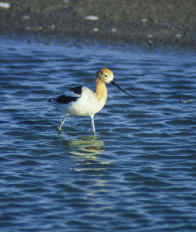
Actitis macularia
Caladris alpina
Caladris mauri
L: 6.5"
Brown top half of body with white underside. This bird is the most common small shorebird in the local marshes and bay shoreline.
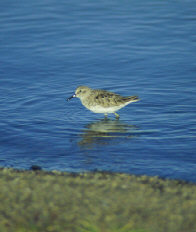
Caladris minutilla
Catoptrophorus semipalmatus
L: 17"
This large shorebird seems a drab gray color until it begins to show its wings. The wings are black and white on the underside. They feed on crabs, clams, and worms using their stout long bill. During the breeding season you can hear their call of "pill-will-willet" from which they are named.
Limnodromus scolopaceus
L: 11.5"
A medium-small shorebird with a long, slowly tapering bill. The coloring is dark grey on the top half of the bird in the winter, in the summer the bird's top half is a brown to reddish brown color. This species is similar to the short billed dowitcher, but has a darker underside and tail that makes the white rump stand out in contrast. Common in marsh ponds and tidal flats.
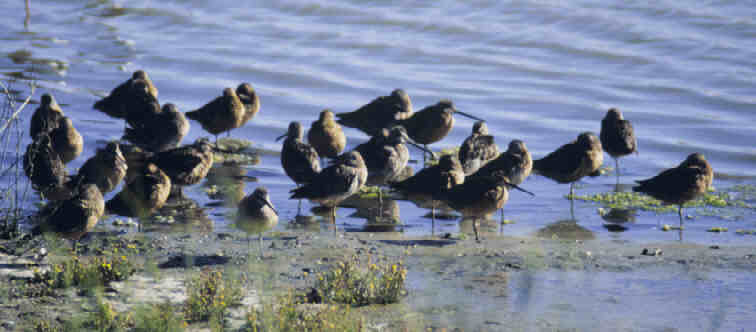
Numenius americanus
L: 23"
A medium-large wading bird that is brown above and buff below. This bird also has a long downward curved bill and long dark legs. A similar bird, the Whimbrel, has a stripped crown and a shorter bill. These birds are commonly seen in salt marshes.
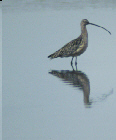
Numenius phaeopus
Tringa melanoleuca
L: 14"
A medium-small shorebird with long, yellow legs and a long slightly upturned bill. The grey back and white underside are drab in comparison to the legs. The call is a loud series of three or more repeated "tew" notes. The similar lesser yellowlegs is smaller, has a shorter, thinner bill and is less common.
